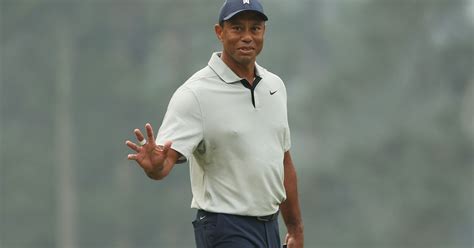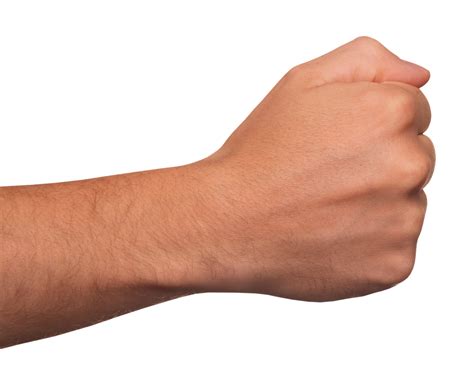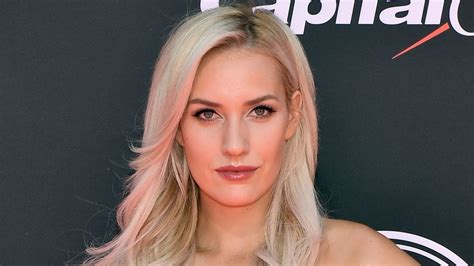
Paige Spiranac jokingly suggests a correlation between wearing less clothing and improved golf performance, sparking online discussion and highlighting the ongoing debate about dress codes on the golf course.
Former professional golfer and social media influencer Paige Spiranac recently ignited a debate on golf attire and its potential impact on performance. In a playful tweet, Spiranac quipped that wearing less clothing might lead to lower scores on the golf course. This remark, referencing her often-discussed fashion choices, has triggered widespread reactions, ranging from amusement to serious discussion about the appropriateness of dress codes in golf.
Spiranac, known for her engaging content and willingness to challenge traditional norms, made the comment amidst discussions about restrictive dress codes in the sport. While her statement was lighthearted, it underscores a larger conversation regarding comfort, personal expression, and the evolution of golf culture.
“Honestly, I just think that wearing less clothing can lead to lower scores,” Spiranac stated, tongue-in-cheek, on social media. The post quickly garnered thousands of likes and shares, generating a flurry of comments both supporting and criticizing her perspective.
The debate surrounding golf attire is not new. Traditional golf clubs have historically enforced strict dress codes, often requiring collared shirts, tailored pants or skirts, and specific types of shoes. These regulations are intended to maintain a sense of decorum and respect for the game’s heritage. However, some argue that these rules are outdated and exclusionary, particularly for women and younger players.
Spiranac has been vocal about her experiences with dress codes, noting instances where her outfits have been scrutinized or deemed inappropriate despite adhering to the general guidelines. She believes that golfers should have more freedom to choose clothing that allows them to feel comfortable and confident, ultimately enhancing their performance.
“I’ve always felt that comfort plays a huge role in how well you play,” Spiranac explained in a recent interview. “If you’re constantly worried about whether your skirt is too short or your top is too revealing, it can distract you from the game itself.”
The discussion also extends to the professional level, where dress codes are somewhat more relaxed but still present. The LPGA, for example, has faced criticism for its policies on acceptable attire, with some players arguing that the rules are overly restrictive and disproportionately target women.
While Spiranac’s comment was made in jest, it highlights a growing sentiment within the golfing community that challenges the status quo. Many golfers, particularly younger generations, are pushing for more relaxed dress codes that reflect a more inclusive and modern approach to the sport.
One of the main arguments against strict dress codes is that they can deter new players from taking up the game. Potential golfers may feel intimidated or unwelcome if they believe they need to invest in expensive, traditional clothing before stepping onto the course. By loosening these restrictions, golf could become more accessible and appealing to a wider audience.
Conversely, proponents of traditional dress codes argue that they are essential for maintaining the integrity and respectability of the game. They believe that adhering to these standards promotes a sense of tradition and professionalism, which are integral to the golfing experience.
“Golf has always been a sport that values tradition and etiquette,” said a representative from a prominent golf club. “Dress codes are part of that tradition, and they help to ensure that everyone on the course is treated with respect.”
The debate is further complicated by issues of gender equality. Historically, dress codes have been more stringent for women than for men, often dictating the length of skirts, the style of tops, and the types of accessories allowed. This has led to accusations of sexism and a call for more equitable treatment.
Spiranac has been at the forefront of this discussion, advocating for a more inclusive and welcoming environment for female golfers. She believes that women should be able to express their personal style on the course without fear of judgment or penalty.
“It’s time to move beyond these outdated notions of what women should wear,” Spiranac asserted. “We should be judged on our skills and our performance, not on our clothing choices.”
The impact of clothing on athletic performance is a complex issue that extends beyond golf. In many sports, athletes are increasingly focusing on clothing that is designed to enhance comfort, flexibility, and mobility. This has led to innovations in fabric technology and design that prioritize performance over tradition.
While traditional golf attire may not necessarily hinder performance, some argue that it can be restrictive and uncomfortable, particularly in hot weather. Allowing golfers to wear clothing that is more breathable and less constricting could potentially improve their swing mechanics and overall performance.
“When you feel comfortable and confident in what you’re wearing, it can definitely have a positive impact on your game,” said a sports psychologist who specializes in golf. “It’s all about feeling good and being able to focus on the task at hand.”
The discussion surrounding golf attire is likely to continue as the sport evolves and adapts to changing societal norms. While there is no easy answer, it is clear that the golfing community is grappling with the need to balance tradition with inclusivity and personal expression.
Spiranac’s playful comment has served as a catalyst for this ongoing conversation, prompting golfers of all levels to reflect on the role of clothing in the game. Whether or not wearing less clothing actually leads to lower scores remains to be seen, but the debate has undoubtedly raised awareness about the importance of comfort, confidence, and personal style on the golf course.
In addition to her advocacy for more relaxed dress codes, Spiranac has also been a vocal critic of body shaming and online harassment. She has spoken out about the challenges she has faced as a female athlete in the public eye, and she has used her platform to promote body positivity and self-acceptance.
“It’s not always easy being a woman in sports,” Spiranac admitted. “But I’m determined to use my voice to create a more inclusive and supportive environment for all athletes.”
Spiranac’s influence extends beyond social media. She has also worked with various organizations to promote junior golf and to encourage more women and girls to take up the game. She believes that golf has the power to teach valuable life lessons, such as discipline, perseverance, and sportsmanship.
“Golf is more than just a game,” Spiranac explained. “It’s a way to connect with others, to challenge yourself, and to learn important skills that can help you succeed in life.”
As the debate surrounding golf attire continues, it is important to consider the broader implications for the sport. By embracing inclusivity and diversity, golf can attract new players, foster a more welcoming environment, and ensure its long-term sustainability. Spiranac’s contributions to this discussion have been invaluable, and her voice will undoubtedly continue to shape the future of golf.
The topic of golf attire has also become increasingly relevant in the context of environmental sustainability. As consumers become more aware of the environmental impact of the fashion industry, there is a growing demand for clothing that is made from sustainable materials and produced in an ethical manner. This trend is also influencing the golf apparel market, with many brands now offering eco-friendly options.
“Consumers are becoming more conscious of their purchasing decisions,” said a representative from a sustainable golf apparel company. “They want to support brands that are committed to reducing their environmental footprint.”
The rise of social media has also played a significant role in shaping the discussion surrounding golf attire. Platforms like Instagram and TikTok have allowed golfers to showcase their personal style and to challenge traditional norms. This has created a more diverse and inclusive online community, where golfers of all backgrounds can connect and share their experiences.
“Social media has democratized the world of golf,” said a social media expert who specializes in the sport. “It has given golfers a platform to express themselves and to connect with others who share their passion for the game.”
The debate surrounding golf attire is ultimately a reflection of the broader cultural shifts that are transforming the sport. As golf becomes more accessible, diverse, and inclusive, it is important to embrace change and to create an environment where all golfers feel welcome and respected.
Spiranac’s contributions to this discussion have been invaluable, and her voice will undoubtedly continue to shape the future of golf. By challenging traditional norms and advocating for inclusivity, she is helping to create a more vibrant and welcoming community for all golfers. The conversation extends beyond mere clothing choices, touching on the core values and traditions that define the sport. It’s a discussion about evolution, adaptation, and ensuring golf remains relevant and appealing to future generations.
The economics of golf attire also play a role in this ongoing discussion. Strict dress codes can create a financial barrier for some, requiring significant investment in specific clothing items. Relaxing these codes could make the sport more accessible to individuals from lower socioeconomic backgrounds, fostering greater diversity within the golfing community.
Moreover, the focus on attire can sometimes overshadow the actual skills and achievements of golfers, particularly women. By shifting the emphasis from appearance to performance, the sport can better recognize and celebrate the talent and dedication of its athletes.
In conclusion, Paige Spiranac’s seemingly lighthearted comment has sparked a meaningful and multifaceted discussion about golf attire, its impact on performance and inclusivity, and the broader evolution of the sport. As golf continues to evolve, it is crucial to engage in these conversations and to create an environment where all golfers feel welcome, respected, and empowered to express themselves on and off the course. The debate encompasses tradition, innovation, equality, and the future of a beloved sport.
FAQ
1. What was Paige Spiranac’s comment about clothing and golf performance?
Paige Spiranac made a tongue-in-cheek comment on social media suggesting that wearing less clothing might lead to lower scores on the golf course. This remark was intended to be humorous but also to highlight her views on restrictive dress codes in golf and advocate for more comfortable and less restrictive attire. As Spiranac stated, “Honestly, I just think that wearing less clothing can lead to lower scores.”
2. Why are golf dress codes a topic of debate?
Golf dress codes are debated because they often enforce traditional standards that some view as outdated, exclusionary, and uncomfortable. Critics argue these rules can deter new players, particularly women and younger generations, and that they prioritize appearance over performance and comfort. The debate also touches on issues of gender equality, as dress codes have historically been more stringent for women.
3. How does Paige Spiranac advocate for change in golf attire?
Paige Spiranac advocates for more relaxed and inclusive dress codes in golf, arguing that comfort and personal expression should be prioritized. She believes golfers should have the freedom to choose clothing that makes them feel confident and comfortable, without fear of judgment or penalty. She has also spoken out against body shaming and online harassment faced by female athletes. Spiranac stated, “It’s time to move beyond these outdated notions of what women should wear. We should be judged on our skills and our performance, not on our clothing choices.”
4. What are the arguments for maintaining traditional golf dress codes?
Proponents of traditional golf dress codes argue that they are essential for maintaining the integrity and respectability of the game. They believe that adhering to these standards promotes a sense of tradition and professionalism, which are integral to the golfing experience. Maintaining these standards also ensures that everyone on the course is treated with respect.
5. How does the topic of golf attire relate to inclusivity and diversity in the sport?
The topic of golf attire relates to inclusivity and diversity because strict dress codes can create a barrier to entry for potential players, particularly those from lower socioeconomic backgrounds or those who do not conform to traditional norms. Relaxing these codes could make golf more accessible and welcoming to a wider range of individuals, fostering greater diversity within the golfing community. The discussion also touches on ensuring that women are not disproportionately targeted by restrictive dress codes.
6. What impact does clothing have on athletic performance?
While traditional golf attire may not necessarily hinder performance, some argue that it can be restrictive and uncomfortable, particularly in hot weather. Allowing golfers to wear clothing that is more breathable and less constricting could potentially improve their swing mechanics and overall performance. “When you feel comfortable and confident in what you’re wearing, it can definitely have a positive impact on your game,” said a sports psychologist who specializes in golf.
7. How has social media influenced the discussion on golf attire?
The rise of social media has played a significant role in shaping the discussion surrounding golf attire. Platforms like Instagram and TikTok have allowed golfers to showcase their personal style and to challenge traditional norms. This has created a more diverse and inclusive online community, where golfers of all backgrounds can connect and share their experiences. “Social media has democratized the world of golf. It has given golfers a platform to express themselves and to connect with others who share their passion for the game.”
8. What role does the economics of golf attire play in the debate?
The economics of golf attire play a role in the debate because strict dress codes can create a financial barrier for some, requiring significant investment in specific clothing items. Relaxing these codes could make the sport more accessible to individuals from lower socioeconomic backgrounds, fostering greater diversity within the golfing community.
9. How is environmental sustainability related to golf attire?
The topic of golf attire has also become increasingly relevant in the context of environmental sustainability. As consumers become more aware of the environmental impact of the fashion industry, there is a growing demand for clothing that is made from sustainable materials and produced in an ethical manner. This trend is also influencing the golf apparel market, with many brands now offering eco-friendly options. “Consumers are becoming more conscious of their purchasing decisions. They want to support brands that are committed to reducing their environmental footprint.”
10. What are the broader implications of the golf attire debate for the future of the sport?
The debate surrounding golf attire is ultimately a reflection of the broader cultural shifts that are transforming the sport. As golf becomes more accessible, diverse, and inclusive, it is important to embrace change and to create an environment where all golfers feel welcome and respected. This involves challenging traditional norms, advocating for inclusivity, and ensuring that the sport remains relevant and appealing to future generations.









